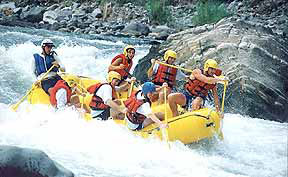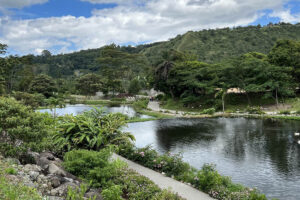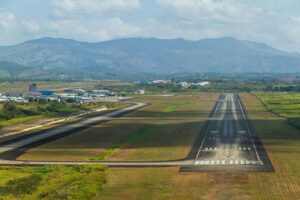Costa Rica Tour Combines Recreation With Conservation and Education
By Kristi Girdharry

Costa Rica is well known for friendly locals and welcoming beaches — a great place to enjoy the beauty of both Caribbean and Pacific waters.
But besides exotic drinks on sun-warmed sand, Costa Rica also offers many educational opportunities for travelers, especially families, who want to learn about Costa Rica’s environment, its wildlife and its agriculture.
Costa Rica’s Tropical Agricultural Research and Higher Education Center, the Savegre Reserve and Ballena Marine National Park combine recreational activities with programs to increase awareness of ecological issues like sustainable agriculture, ecotourism and economic development that is beneficial for people and for the environment.
Adventure Life of Missoula, Montana, offers many Costa Rica tours to take advantage of these educational opportunities through biking, horseback riding, river rafting, and hiking trips with professional guides.
CATIE
Costa Rica’s Tropical Agricultural Research and Higher Education Center, better known as CATIE, is located in Turrialba, about two hours from the capital of Costa Rica, San Jose.
CATIE’s history dates back to May of 1940, when a group of far-sighted people, including US Agriculture Secretary Henry Wallace, proposed the creation of an institute dedicated to tropical agriculture.
Today CATIE has become an internationally recognized agricultural research center committed to sustainable rural development which conducts research into sustainable agriculture and agroforestry systems. The graduate programs in natural resource management attract professionals from around the world.

Besides developing new ideas in education and agriculture, CATIE maintains a network of trails where travelers can see and learn about local crops. There are guided tours where visitors can see shade-grown coffee, cocoa, bananas, macadamia, mango, avocado and sugarcane, and visit the botanical gardens where many of the world’s most important tropical plant species are being cultivated and protected as a genetic resource bank.
These is so much to see that Adventure Life’s Discover Costa Rica Tour spends a whole day biking here.
Described as a “comfortable” ride, the biking tour takes easy gravel paths, country roads and farm trails making the four-hour ride manageable for different ages. What sets this tour apart from other biking tours is CATIE’s aim to increase awareness of ecological issues and sustainable agriculture and agroforestry.
Travelers will learn about planting techniques and agriculture, while getting the chance to sample fresh Costa Rican produce. Travelers will also see and learn about the various animals that are also drawn to the fruits and plants located on the grounds of the center.
The Pacuare River

After a day of easy biking at the CATIE center, the Discover Costa Rica Tour speeds up a bit, taking travelers rafting down the rapids of the Pacuare River.
Rated one of the best five rafting rivers in the world, the Pacuare River offers an exciting rafting experience. A little hard work goes a very long way here: rafters will be rewarded with tropical scenery and a combination of white water and clear pools.
Those venturing the Pacuare River will find themselves rafting through deep mountain gorges, over running waterfalls, and into lively rainforests brimming with the sounds of Costa Rica’s resident wildlife. The steep, green walls of the gorge give you a feeling of isolation, and listening to the calls of the animals gives you a feeling of connectedness with nature.
Although this river is not overly challenging, there are a lot of rapids, so rafters are sure to be in for a fun ride. All levels of rafters can enjoy the trip, but the suggested minimum age is 14 years old.
Turrialba Valley
The name Turrialba is derived from the indigenous word “Torriulka,” meaning “white columns of smoke and water” referring to the steam rising from the nearby Irazu and Turrialba Volcanoes and the rivers and waterfalls.

According to travelers, one of the best things about Turrialba is the fact that it is not a huge tourist spot. The valley of Turrialba supplies drinking water and hydroelectric power to the region ande provides habitat for an incredible number of species of wildlife. In this valley alone there are more than 550 different types of birds, 150 different mammals and more than 130 species of amphibians and reptiles.
Guayabo National Monument
The 3,000 year old Guayabo National Monument, located north of Turrialba, is considered the most important archaeological site in Costa Rica. This ancient city is an overall intriguing place: it was home to about 10,000 people who seemed to have just vanished before the arrival of the Spanish in the 16th century.
Who were these people? What happened to make them vanish?
Since there were no great civilizations in the region such as the Mayans or Incas, very little is known about these mysterious inhabitants who once lived in this region. Discoveries are still being found and adding to Costa Rica’s history every year.
Guayabo National Monument is also home to colorful butterflies and birds as well as various animals and plants. But perhaps some of the most interesting things to see here are the “petroglphs” — ancient abstract carvings that appear everywhere. Some obviously represent animals, while others seem to have no clear meaning at all. Although these petroglphs continue to baffle archaeologists, they do enhance the mystery of Guayabo.
Savegre Reserve

Made of up 1,000 acres of forest, 80 per cent of which are virgin, the Savegre Reserve is used as a living research laboratory by institutions from around the world. The reserve is known as one of the best places to view the Resplendent Quetzal — a bright red and green feathered bird that is a favorite of both the novice and experienced birdwatcher.
The Savegre Reserve has many recreational activities for people of all ages. Thrill seekers can sail along on “zip lines” through the rainforest canopy. Fishermen can try their luck catching trout. There are also opportunities for horseback riding or simply viewing the spectacular scenery.
The Pacific Coast
Bellena Bay is home to some of Costa Rica’s most pristine beaches. Playa de Arco, a beach surrounded by rainforest, is part of Ballena Marine National Park, which was created to protect coastal marine habitats. Endangered species like the Pacific hawksbill turtles live and nest here, and whales from both hemispheres come here to give birth in the spring.

Playa de Arco gets its name from a large cave that runs between one part of the beach and another. At low tide travelers can walk through the dark cave and enjoy faint glimmers of light reflected on its wet walls and sound of waves surging in from either side.
Bellena Bay protects Playa de Arco, so its waves and currents are much gentler than most beaches along the Pacific. This makes it an ideal place for families to enjoy swimming, boogie boarding, and surfing lessons with resident professionals.
La Cusinga
Also located on the Pacific coast, La Cusinga offers both seclusion and opportunities for adventure, making it an ideal place for families with different tastes. Scuba diving and snorkeling are popular things to try, but there’s always the old standby: relaxing on the beach.
If you’ve had enough of the beach, there are miles of private mountain trails. There are also rainforest tours that will introduce you to capuchin monkeys, toucans, coatimundis and more. Other tours are available to teach you about edible and medicinal plants.
Ecotourism at Its Best
More than one fourth of Costa Rica is protected by national parks, reserves, or private foundations. A Costa Rica tour is a way to view conservation at its best and explore examples of successful eco-lodges, ecotourism, and preservation efforts.
To take a deeper look into ecotourism options, visit Costa Rica Travel Info which gives a list of destinations, background information and travel options.
- These 9 U.S. National Parks Require Reservations in 2024 - April 17, 2024
- Take a Hike in Olympic National Park - April 17, 2024
- The Wild Mississippi: 2340 Miles Across Ten States - April 8, 2024





